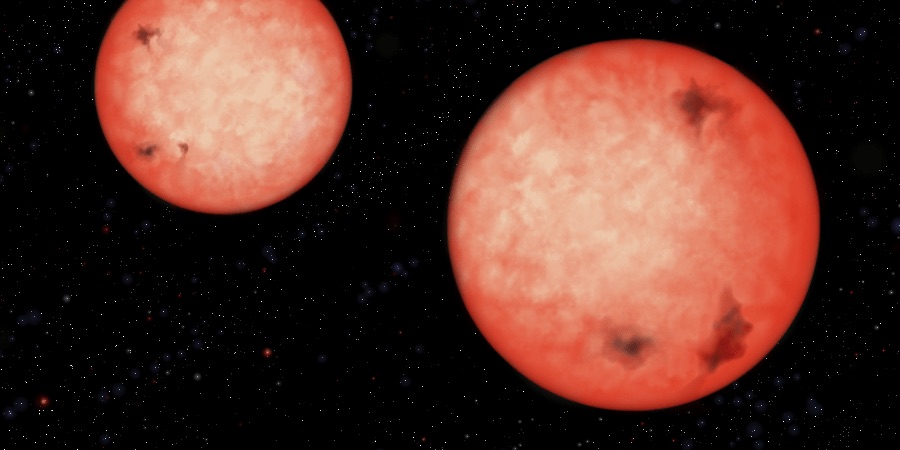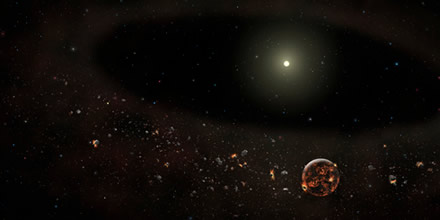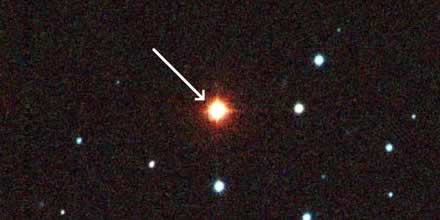Current Research
My research aims to better understand our young stellar neighbours, particularly at the lowest masses and youngest ages. These nearby (<100 pc), young (<100 Myr) systems provide unique tests of pre-main sequence stellar evolution and the late stages of protoplanetary disc evolution, and are some of the best targets for directly imaging giant exoplanets.
Below are just two of the interesting topics my collaborators and I are currently working on. If you are interested in joining us at UNSW Canberra to continue this work, please get in touch to find out more!
'Peter Pan' discs around juvenile stars
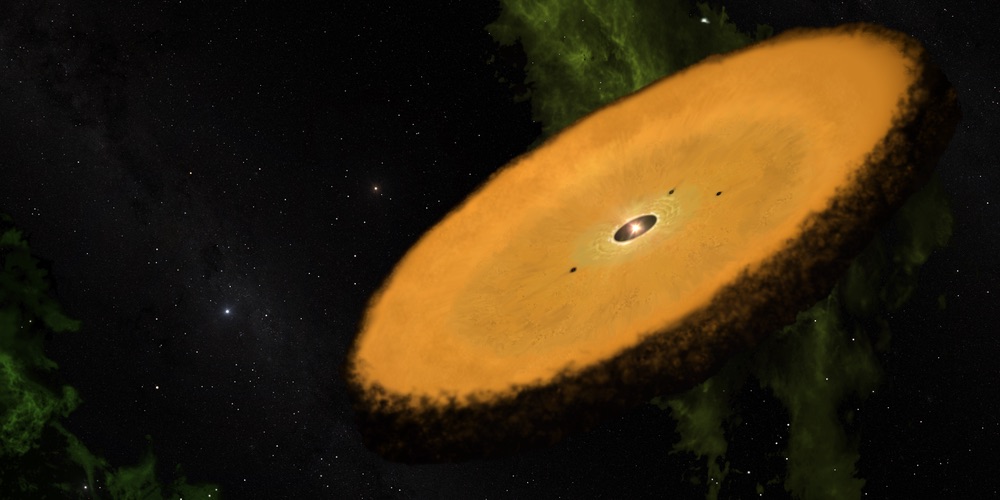
Artist's impression of the 'Peter Pan' circumstellar disc around WISE J080822.18-644357.3 (Credit: NASA Goddard Space Flight Center/Jonathan Holden).
A young star with a 'Peter Pan' disc retains its circumstellar gas and dust for tens of millions of years, much longer than the typical disc lifetime of a few million years. In other words, a star that refused to 'grow up'!
Starting with the discovery of a disc and accretion around the 45 million year-old M-dwarf WISE J080822.18-644357.3, there are now at least half a dozen juvenile (>20 Myr) low-mass stars known to host substantial amounts of dust and gas. These 'Peter Pan' systems raise interesting questions about the evolution of circumstellar material around the lowest mass stars:
- How long can gas and dust persist around low-mass stars?
Our recent discovery of ongoing accretion around the Argus Association member 2MASS J15460752-6258042 shows that gas-rich inner discs can support low levels of accretion for at least 50 million years. The M5 star shows strong and variable optical emission (e.g. Hα, He I, [OI]) as well as infrared excess at 11 and 24 μm, very similar to WISE J080822.18-644357.3. - What can Peter Pan systems teach us about planet formation?
The simplest model to explain Peter Pan discs is that primordial (i.e. first-generation) gas and dust around M-dwarfs takes longer to dissipate than around their higher-mass cousins. This means that the time available for planet formation around M-dwarfs could be much longer than previously thought, permitting the formation of gas-giant planets at late ages, in contradiction to most planet formation models. - What are the circumstellar environments of Peter Pan systems?
We recently obtained ALMA observations of the prototype Peter Pan star WISE J080822.18-644357.3 which did not show the presence of cold CO gas, seemingly ruling out a primordial protoplanetary disc. The small amount of cold dust we saw is consistent with a second-generation collisional cascade of rocky bodies (i.e. a debris disc). However, this scenario still requires a long-lived gas reservoir close to the star to explain the spectroscopic accretion signatures, raising the question of why gas has persisted around this star and not others?
The young groups η (eta) and ε (epsilon) Chamaeleontis
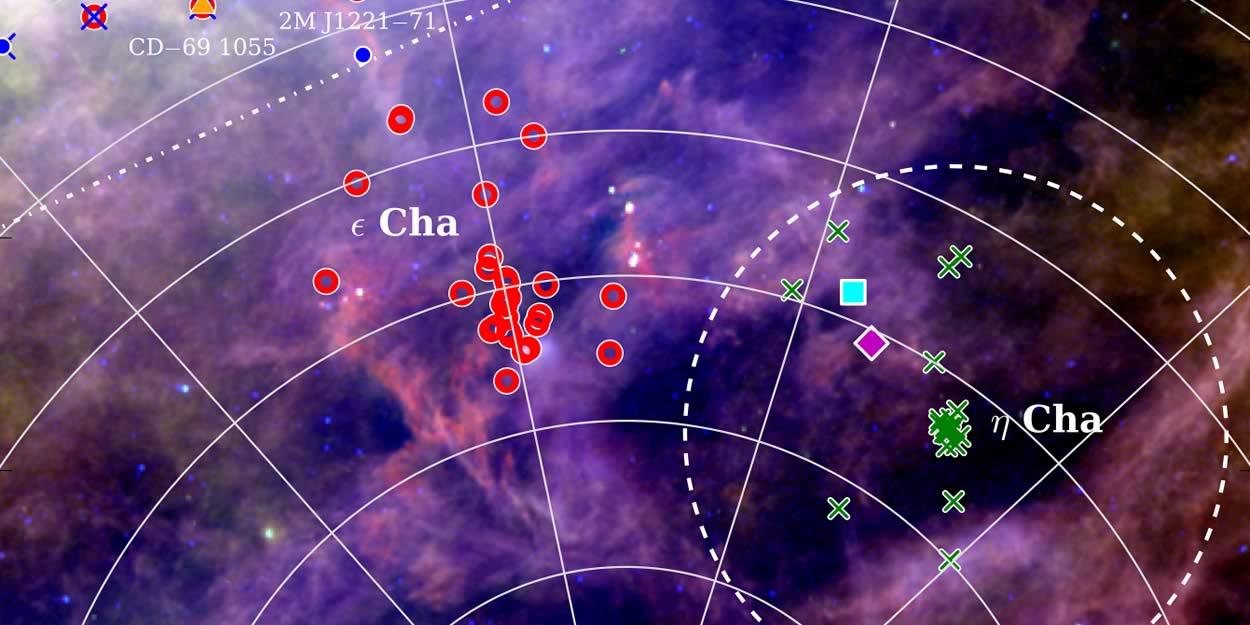
Infrared Astronomical Satellite (IRAS) 25/60/100 μm colour composite of the Chamaeleon region, showing the young open cluster η Cha, the ε Cha Association and the background Chamaeleon dark clouds. The dashed line around η Cha shows the 5.5 deg radius of our search for halo members of the cluster.
Two of the most intriguing and understudied young moving groups in the southern sky are the open cluster η Cha and the ε Cha Association. Both are <10 million years old and only 100 pc away, making them some of the youngest stars in the Solar neighbourhood.
For several years we have been conducting a systematic investigation of these groups and the young stars in their vicinity. This has already lead to several notable discoveries:
- The low-mass stellar halo around η Cha
The central core of η Cha appears to be missing many low-mass stars, we believe due to dynamical evolution, which dispersed them to large radii. From a wide-field photometric and proper motion survey around η Cha, we discovered several young, low-mass stars up to 5 degrees from the cluster. These stars have proper motions and radial velocities consistent with ejection from η Cha over the past 5-10 Myr. - Episodic accretion in 'old' pre-main sequence clusters
Several members of η and ε Cha showed strong and variable Hα emission in our ANU 2.3-m/WiFeS spectra, including one star with signs of circumstellar accretion. Infrared photometry from the WISE satellite confirms the presence of a disc around the star and demonstrates that accretion can continue at low levels long after the majority of circumstellar material has dissipated, much like in 'Peter Pan' systems. - A wide, fragile pre-main sequence binary born in Sco-Cen
Two of the η Cha halo candidates appear noticeably older than the cluster and are only 42" apart on the sky. We have shown that they are almost certainly a 10 million year-old binary system. New astrometry from the Gaia mission confirms the stars are moving through space together and are 4700 AU apart at a distance of 112 pc. The dynamical fragility of this wide binary puts strong constraints on its birthplace, which we believe was in the Sco-Cen OB association.
Background image credit: Akira Fujii.
I acknowledge that I live and work on the land of the Ngunnawal people, and pay my respects to their Elders, both past and present.
